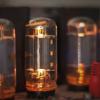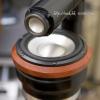Friends, to talk about computer power supplies, I need to go back a bit. My first fully dedicated computer was a Core2Duo E7500 with 2GB of DDR2 RAM. I always followed with common computer power supplies, never something different. Soon after having set up an Intel J1900-based computer, however, I began to dedicate myself to power it. I started with a very simple power supply: it had a toroidal of 15VAC, 20,000uF of capacitance and diodes MUR860. Nothing more. I bought in China a PSU that worked from 16 to 24v and, so, the idea seemed perfect: working the power supply in the 20v DAC range, when the mains voltage was 120v AC, the voltage could rise to 144v and go down to 96v without leaving the working range of this PSU. That is, the risk of damage was almost non-existent and the construction extremely simple. The power supply picked me up for a long time, and then I made certain adjustments to it. I found that the wire that connected the output to the PSU contained a resonant harmonic whose frequency and its multiples corresponded to the length of the wire itself. So, I immediately added a WIMA capacitor of 0.1uF to the PSU input, which gave me a relatively interesting cleaning in the high frequency range. This, coupled with the computer's cabinet grounding, was responsible for removing significant barriers to my system's performance. After that, still pretending to get even better power, I provided countless auditions with different batteries. I used automotive batteries, cell phone batteries, aeromodelist batteries, among many others. There was a time when I was powering the computer as follows: a 12V automotive battery for the PSU to generate voltages for the motherboard; a 9v battery for the USB SOtM card; a portable 5v cell battery for the HD and the SSD. Additionally, the SOtM dx-USB HD also used a 12v battery. The battery tests started with the storage drivers and, given the improvements they made, they took over the whole computer. However, instead of continuing to use the batteries, I adopted their benchmark performance to try to optimize that linear power supply I had already built. The best way I found, at first, was to increase capacitance to 50,000uF and improve capacitor quality. I started using the Nichicon Gold Tune of 10,000uF each, added to some other implementations.
At first, I could observe the following: a) ALL the batteries with the same compound have approximately the same sonority. Lithium batteries play approximately equal, and nickel-cadmium and zinc-carbon batteries (I think this is related to the noise that the chemical reaction of the compounds can generate); b ) among the batteries, the number of cells can impair the sound, because there's a certain resistance between each one, and the more cells there are, the worse for the final result; c) an intermediate linear power supply gained in dynamic and transient sounds (e.g., drum plates, large orchestral masses), whereas the battery is superior in continuous and sustained sounds, such as a saxophone, a flute, solo voices; d) any battery plays with more silence, cleanliness, delicacy, softness than a linear input power supply or medium. The reasons for this are several, but the most latent is the fact that the battery has a "clean energy." On the other hand, a high-level linear power supply can play MUCH better than a battery, with more life, dynamics and body, and for that a more elaborate project is needed, with some care that I will explain. One solution that actually works is to use much more capacitance than is normally needed in a linear power supply, in order to create an extremely disproportionate bank that simulates a kind of battery (my computer, for example, had 50,000uF of capacitance before the current version (which I call MK III). I have achieved a hybrid system, with a linear power supply and interposed capacitors, which, in addition to the function of stabilization and ripple reduction, have the function of a "virtual battery". Thus, the first assumption of high throughput is: high capacitance.
Another important issue is the voltage regulator. I have tested several LM, TDA and LT regulators. I noticed that each one has its own sound characteristics, and although it hasn't tested all the available ones in the market, it seems to me very difficult or impossible to find some that's completely invisible. Among them, the best voltage regulators are the LT, especially LT1084 and LT3045, which I really like. However, an electric circuit is necessary for the regulation, and this whole circuit ends up causing harm to the audio, in some cases. The best, therefore, would be to create a linear power supply without a regulation sector. This means that the output DC voltage will vary depending on the AC voltage of the outlet. Then you could ask me: but is not that dangerous? Let's do a calculation: the Mini-Box M4-ATX (which I use) accepts voltages from 6 to 30v. Assuming our linear supply will have 20v without regulation for a nominal 120v voltage, that means we would only reach the 30v limit with 180v AC voltage. Now, if the voltage reaches 180v (which is very unlikely), our last concern will be the computer. Thus, the second assumption of high throughput is: absence of voltage regulator circuit. (In the case of the M4-ATX, which I have and I know very well, I can assure you that it's very transparent to what's behind, to the sonority that the power supply prints to the computer. That's why in the fine tuning of sound I only stick to the DC power circuit of the M4-ATX. However, and here is the interesting part, there is currently a voltage regulator that I consider unbeatable in sound quality: the LT3045. The disadvantage is that it is only made for 0.5A (some circuits with two support 1A, so I was experimenting with the power of the SSD, but as I removed it from Audio-PC, I haven't yet reached a conclusive result. I believe that to power SSDs and dedicated low-power PCI-Express cards, LT3045-based controllers today are the best in sound quality, but this demands more thorough testing, which I didn't do).
Continuing. Capacitors, resistors, diodes, all have their own "sonority". A bad capacitor in the middle of the path will make the whole circuit go back. It will be a very disastrous thing to take care of certain aspects of the power supply and forget about the quality of the material. I recommend using Nichicon Muse (KZ) capacitors, which are the ones I used in the small linear power supplies I built. The price isn't high and the difference for the better isn't small. As diodes, among the several that I tested and are more accessible, I suggest the MUR860 and MUR1520. The UF (ultra-fast) are also very good, but the sound is more metallic, not so pleasing. I definitely don't recommend the use of diode bridges, with one exception: IXYS brand. Without prejudice, for me, the best diodes for audio today are the Schottky (SiC). These are the ones I've used on every project. If you cannot use SiC, you'd use the IXYS bridge. They're the best I know. I cannot name capacitors because each one has particular sonorities that can fit better with each one's systems. I have preferred the Nichicon Gold Tune for value for money, but Epcos is also very god. Thus, the third assumption of the high yield is: component quality.
The boards on which these circuits are mounted also have their own sound. This is evident, since various qualities of copper, various fiber thicknesses, or other material may be used, and this reflects in the final quality. In order to escape this kind of problem, I suggest something simple, which effectively produces results, although it can be aesthetically ugly: direct connection, point to point, and symmetrical between polarities. There's nothing more "perfect" and precise than the direct connection from one component to another without a board, only using the conductors of the components themselves and soldering. I assure anyone who ventures to build a power supply that won't be able to find a better way to make the connection, although the aesthetic isn't the best. Thus, the fourth assumption of high throughput is: direct connection between components.
As a next aspect, in a general overview I'm trying to do, we have the transformer. There's a wide discussion about which is the best for audio, with the E/I model encountering strong defenders, and the toroidal also encounters other strong defenders (as well as the R-core). I particularly like the insulating type toroidal. For good performance, however, a few more attentions need to be taken: a) the efficiency of the transformer is directly connected to the core material and the tightness of the wires around it. Typically, toroidal transformers with silicon core and well coiled achieve efficiency in the house of 90 to 95%; b ) the quality of copper is fundamental; c) whenever possible, electromagnetic shielding should be chosen. It makes no sense for a transformer to effectively isolate the primary and the secondary and on it can be electromagnetic waves that foul the quality of the energy; d) a major ally in noise reduction is the primary transformer. If it has a higher than normal inductance, the transformer will be more immune to changes in the electrical network and will be much more stable and quiet. Thus, the fifth assumption of high efficiency is: insulating transformer with silicon core, electromagnetic insulation and higher inductance in the primary.
As a penultimate aspect, I cite the capacity of the supply. Power supplies that work on or near the edge always lose some income. It better be oversized. In my case, the Audio-PC consumes in the range of 20 to 25w, and its linear power supply has capacity for up to 120w. Being far from its limit, there's always better performance, and this is the fifth assumption of high performance
Finally, something that I consider indispensable, to add to the insulation of the transformer, is the high frequency filtering. Please, note: no transformer is 100% efficient in insulation between primary and secondary, so some "dirt" can pass through it and degrade power quality. And not only that. The reverse path is also true. The equipment itself, in this case the computer, can generate high frequency noise, noise that's able to "return" through the power circuit and dirty the power of other equipment. Thus, it's important that there's a filter circuit, however minimal. The capacitors of the bank will do this in an inefficient way, so, as a complement, it's interesting to add a capacitor in parallel, after the larger capacitors, in the last step of the power supply. This capacitor can have a value of 0.1uF, can be from film/MKP/WIMA and, the closer this capacitor is to the PSU (in my case, the M4-ATX), the better it will avoid feedback from the wiring hamonics. I don't recommend polyester because of its fragility, nor is it electrolytic due to electrical characteristics, Another interesting factor related to the subject is the inductance. Filtration through inductors creates effects that are completely detrimental to audio. I've tried to put inductors of the most diverse species and, even, to make inductors with the own wiring of the power supply. Not important if the inductor has air core or ferrite, it always harms the audio. The only thing I tested in series with the power supply and that doesn't generate negative effects to the audio is the resistance. By placing one or more resistors in series in the circuit, we can greatly attenuate the noise, and the only change that will occur will be that caused by the sound of the resistor itself. For example, a 0.5 ohm resistor associated with a capacitance of 10,000uF is tuned to 31.831Hz, so, at 60Hz there will already be an attenuation next to 20dB of electromagnetic noise and, at 120Hz, an attenuation close to 40dB. Thus, the sixth assumption of high yield is: adequate filtration.
Note that none of this is simple, and creating the circuit and making it work in practice is quite complex. Even so, I believe that with these steps the vast majority will be able to develop their own circuits and obtain an excellent result with a relatively small cost. Honestly, I cannot conceive how a battery, however good it is, can play better than a linear power supply built with such care. I can assure you of that. As a last point, I would like to point out that although I like the result of the full-ATX power supplies (with regulators and totally unrelenting voltages), I think the result of the model I created can reach higher level, although in my case it does not reach high powers, due to the high filtration. To do this, I need to change my project, but it is also perfectly possible. In any case, I've never tested the linear power supply that is sold by JCAT.
Hope it helps...



















